12 Reasons Why Gold is Going Higher
[Whatever you want to] call it – a bubble, a frenzy or a mania – there seems to be a large number of voices in the marketplace who just are not fans of gold, whether prices are moving up, down or sideways [but] the reality is that gold doesn’t possess the traits necessary for a financial bubble to form. [In fact, the current worldwide economic and fiscal environment suggests that gold will go even higher. Let me explain.] Words: 2368
So says Frank Holmes (www.usfunds.com) in an article* which Lorimer Wilson, editor of www.munKNEE.com, has further edited ([ ]), abridged (…) and reformatted below for the sake of clarity and brevity to ensure a fast and easy read. I have added 15 hyperlinks – yes, 15! – to other articles to support and expand upon Holmes article to make it the most comprehensive of any such article to be found anywhere. (Please note that this paragraph must be included in any article re-posting to avoid copyright infringement.) Holmes goes on to say:
Naysayers started calling gold a bubble back when prices hit $250 an ounce and though gold’s bull market has tossed and flung the bubble callers around for almost a decade now, their voices have only gotten increasingly louder as prices broke through $1,000, $1,200 and now [almost] $1,500 an ounce. [In fact,] however, gold prices appear asymptomatic of the signs generally associated with financial bubbles.
12 Reasons Why Gold is Not in a Bubble
The reality is that gold doesn’t possess the traits necessary for a financial bubble to form. Rodney Sullivan, co-editor of the CFA Digest, has done some great research on the history of markets and bubbles going all the way back to the 1600s. He discovered three key patterns in the 47 major financial bubbles that occurred over that time period, namely:
- financial innovation which initially benefits society as a whole
- investor exuberance where usage of these innovations broadens to become mainstream and attract speculation, and
- speculative leverage when these speculators pile on massive leverage hoping to achieve greater success and this excessive leverage adds increased complexity, which mixes with irrational exuberance to create an imbalance in the marketplace. Eventually, the party comes to an end and the bubble bursts..
1. Standard Deviation Move of Gold Remains Low
…[The increase in the price of gold] from under $1,000 an ounce to over $1,420 over the past six months represents only a 0.7 standard deviation move according to Credit Suisse (CS). The average standard deviation move of other bubbles—Japanese equities in 1986, the tech boom in 1999, the GSCI in 2005 and gold in 1979—is 5.3. Gold’s 180 percent move in 1979 represented a 10.3 standard deviation move, more than 14 times the magnitude we see today [see here for a chart illustrating the magnitude of the move then vs. now].
2. Private Ownership of Gold Remains Low
Gold as an asset class is far from being overbought by speculators. Eric Sprott recently did a fascinating presentation explaining how under-owned gold is as an asset class. Sprott wrote [see article here] that despite a 30 percent increase in gold holdings during 2010, gold ownership as a percentage of global financial assets has only risen to 0.7 percent. That’s a big increase from the 0.2 percent level in 2002, but Sprott points out that it’s misleading because the majority of that increase was fueled by gold appreciation, not increased level of investment.
Sprott estimates that the actual amount of new investment into gold [bullion] since 2000 is about $250 billion compared to roughly $98 trillion of new capital into other financial assets over the same time period. Gold equities have seen even lower levels of investment. From 2000 to 2010, $2.5 trillion flowed into U.S. mutual funds, but only $12 billion of that went into precious metal equity funds… [even though] those figures were significantly impacted by the advent of gold ETFs during the decade…
3. Gold as a Percentage of Global Financial Assets is Low
The bar chart [below] from CPM Group shows gold as a percentage of global financial assets over time. In 1968, gold represented nearly 5 percent of financial assets. In 1980, the level had fallen below 3 percent. That figure had shrunk to less than 1 percent by 1990 and has remained there since. Sprott wrote that “it is surprising to note how trivial gold ownership is when compared to the size of global financial assets.”
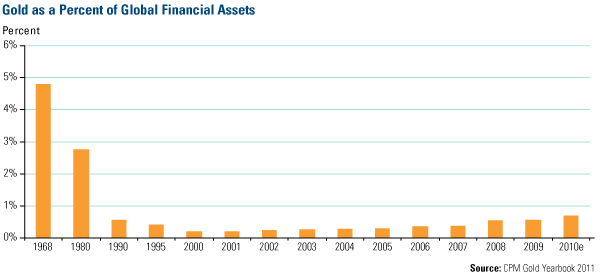
4. Institutional Investments in Gold are Low
That point is magnified by the pie chart from Casey Research. Dr. Marc Faber included it in his April newsletter to show just how small a portion gold and gold stocks are for large institutional investors like pension funds. [Read this article for more insights into gold ownership by pension funds.]
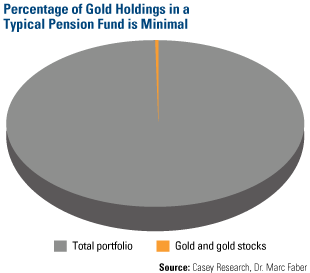
5. Lack of Leverage in Purchasing of Gold
Bubbles require massive leverage and there’s no evidence investors are borrowing to load up on gold. Below is a chart of the trajectory of three bull markets – gold beginning in 1971, the NASDAQ beginning in 1990 and gold again beginning in 2001 – [showing that gold has a long way to go up before it is in bubble territory].

6. Negative Real Interest Rates and the “Fear Trade”

In the U.S., we’re in the middle of an extended period of negative real interest rates that will likely last through the year. The Federal Reserve is acutely aware that if interest rates should spike that it would be catastrophic for the economic recovery…and, historically, it takes approximately four years to heal from any contraction. The U.S. economy is on the road to recovery but the elevated number of home foreclosures and high unemployment make it unlikely the Fed will risk a relapse by raising interest rates any time soon. The government is also unlikely to cut spending or welfare support during the healing process.
7. Continued Weakness in the U.S. Dollar
In the near-term, gold prices are being buoyed by continued weakness in the U.S. dollar. [See here for an enlightening view on what can be expected for the U.S. dollar]. The Trade-Weighted Dollar Index (DXY) is just above the lows experienced during November 2009 and is only 8 percent above the “critical” March 2008 low, according to BCA Research. BCA says the U.S. dollar’s weakness is driven by four factors:
- Federal Reserve balance sheet expansion via QE2
- Low real interest rates, steeply upward-sloped yield curve and perky inflation expectations that should continue in the U.S.
- Plans by the European Central Bank to raise rates later this month
- Willingness of Chinese authorities to allow for yuan (RMB) appreciation when the U.S. dollar is weak
As for deficit spending, we still have an oversized government, creating regulatory traffic jams for business development and hurdles for economic trade [and] whenever there is a structural imbalance between a country’s monetary and fiscal policies, gold tends to perform as a “safe haven” currency. Currently, the quantitative easing measures implemented by the Federal Reserve and the significant size of the deficit spending by the government to increase entitlements to ward off a recession have created a significant imbalance between monetary and fiscal policies. This has devalued the U.S. dollar which, in turn, has boosted gold prices.
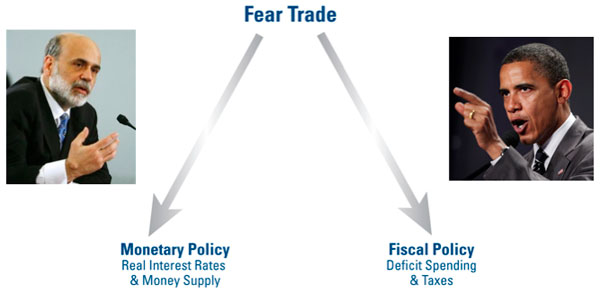
We believe that as long as the U.S. government refuses to trim entitlement and welfare programs and continues to keep Treasury bill yields below the inflation rate to battle deflation, gold will remain an attractive asset class.
8. Higher Inflation
Whenever you have increased deficit spending, rapid money supply growth and negative real interest rates—that’s when the inflation rate is higher than the nominal interest rate—gold tends to perform well in that country’s currency. So far we have not seen rapid money supply growth here in the U.S., but the other two factors have been the main thrust behind gold’s record rise. [Go here for some major insights into why increased inflation bears well for the future price of gold.]
GFMS CEO Paul Walker echoed those drivers in an interview with MineWeb this week. Walker said that “ultra-low interest rates, macro-economic dislocation, fears of global imbalances…the wrath of these things still remain solidly in place and that’s really the bedrock of the gold bull rally.”
9. Continuing Low Interest Rates
The combined $6.3 trillion of excess leverage in the G4 economies (U.S., eurozone, Japan and Great Britain) means that their central banks will be forced to push real interest rates down to abnormally low levels. You can see from the chart [below] that this is quite bullish for gold prices. Any time the real Fed funds rate is below 2 percent, gold tends to rise. [See here for a detailed analysis on this relationship].
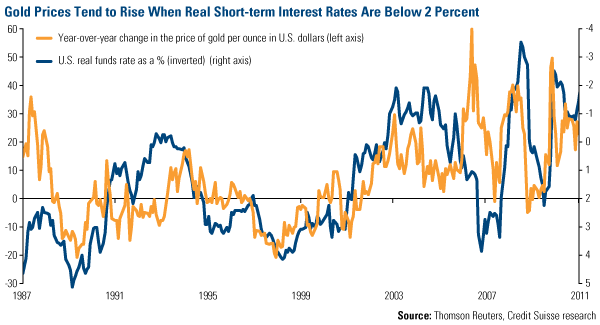
10. Rising Developing Countries’ Affluence and the “Love Trade”
The love trade is significant and unique to gold. People buy gold out of love and those in emerging markets are especially amorous of the metal. Below we refer to the most populous seven of the emerging economies as the E-7… [and they] hold nearly half of the world’s population but make up less than 20 percent of global GDP. The G-7 industrialized nations…[on the other hand,] host 11 percent of the world’s population but control more than 50 percent of the global economy. Things are changing, however.

Many people in emerging countries have a strong cultural attraction toward gold – a much stronger connection than that of the developed world – and that is essential for rising gold demand. It is customary in most emerging countries to give gold as a gift to friends and relatives for birthdays, weddings, and to celebrate religious holidays.
In December, the Shanghai Gold Exchange reported that China imported five times more gold in 2010 than 2009 and that was just during the first 10 months of the year. In India, spending on gold rose 100 percent on a year-over-year basis through September, according to Morgan Stanley. Russia’s central bank holdings of gold rose 7 percent in 2010. What is important to remember when looking at the history of gold is that in the 1970s, China, India and Russia were isolationists with no significant global economic footprint. The world’s population was 3 billion and today we have witnessed an awakening of epic proportions. These countries are growing with free market policies and massive infrastructure spending.
In the 1970s, gold rose on the fear trade and the cold war. Today the world is significantly different and the love trade drives gold. If QE2 was the fuel that sent gold prices to the moon, the gold holiday season was the vehicle they rode in. Gold prices rose steadily as Ramadan came early, which then carried into the Diwali season of lights in India. Then came Christmas, with shoppers around the world spending more than they had in years.

11. Growing Money Supply
When we compare the G-7 countries to our E-7 countries – the world’s seven most populous nations – it is evident that while the G-7 represents 50 percent of global GDP it only represents 10 percent of the total global population while, on the other hand, the E-7 represents roughly 50 percent of global population but only 18 percent of global GDP. We would like to point out that money supply and GDP per capita is rising substantially faster in the E-7 (17.7%) than it is in the G-7 (3.7%). If money supply growth in the E-7 continues at a rate of 15 percent or more, it would be a strong catalyst for higher gold prices.
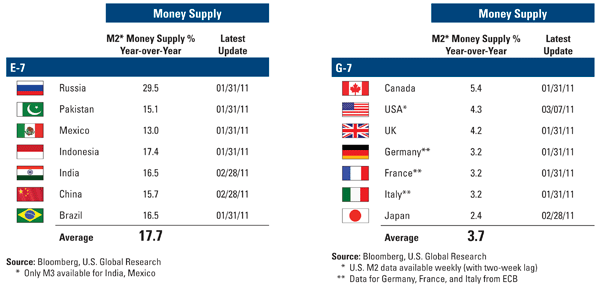
12. Continuing High U.S. Federal Deficit
Current projections from the Congressional Budget Office (CBO) have the U.S. federal deficit at $1.5 trillion. To show the effect this has had on gold prices, we overlaid the rise in U.S. federal debt with the price of gold.
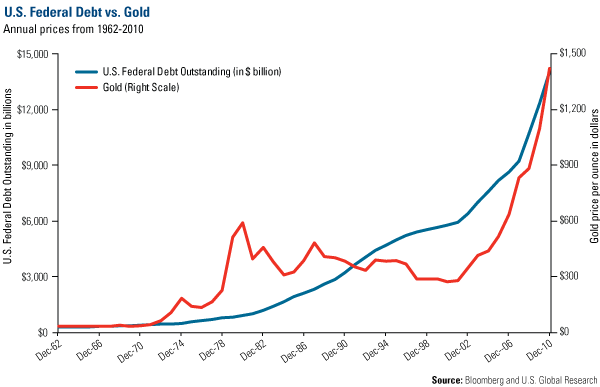
You can see from the chart that gold’s bull run began in 2002, about the same time federal debt began to rise significantly. Gold played catch up at first, but the two have tracked each other rather closely. Since 2002, gold prices have risen 308 percent versus a 119 percent increase in federal debt. This means that gold’s sensitivity to a rise in federal debt is just over 2-to-1. With lawmakers in Washington, D.C. still squabbling over where and by how much to cut the budget, it’s unlikely the federal debt level will recede any time soon.
How Much Higher Will Gold (and Silver) Prices Go?
[All of the above-mentioned] reasons are very constructive for long-term gold prices, but just how much depends on who you ask. Longer term 86 other analysts predict that gold will rise above $5,000 before the bull market in gold is over (see here) and an analysis of the historical gold:silver ratio suggests that silver will go proportionally higher (see here for the complete analysis). If you have now concluded that you should buy some gold – or perhaps even more gold as the case may be – but are not sure exactly how much would constitute a prudent amount please read this article on the subject and this article as to why even a greater percentage may be the way to go.]Conclusion
Based on the above factors and trends, we believe gold could DOUBLE over the next five years.
*http://www.usfunds.com/investor-resources/investor-alert/; http://dailyreckoning.com/visual-evidence-to-disprove-the-gold-bubble-theory/
 munKNEE.com Your Key to Making Money
munKNEE.com Your Key to Making Money